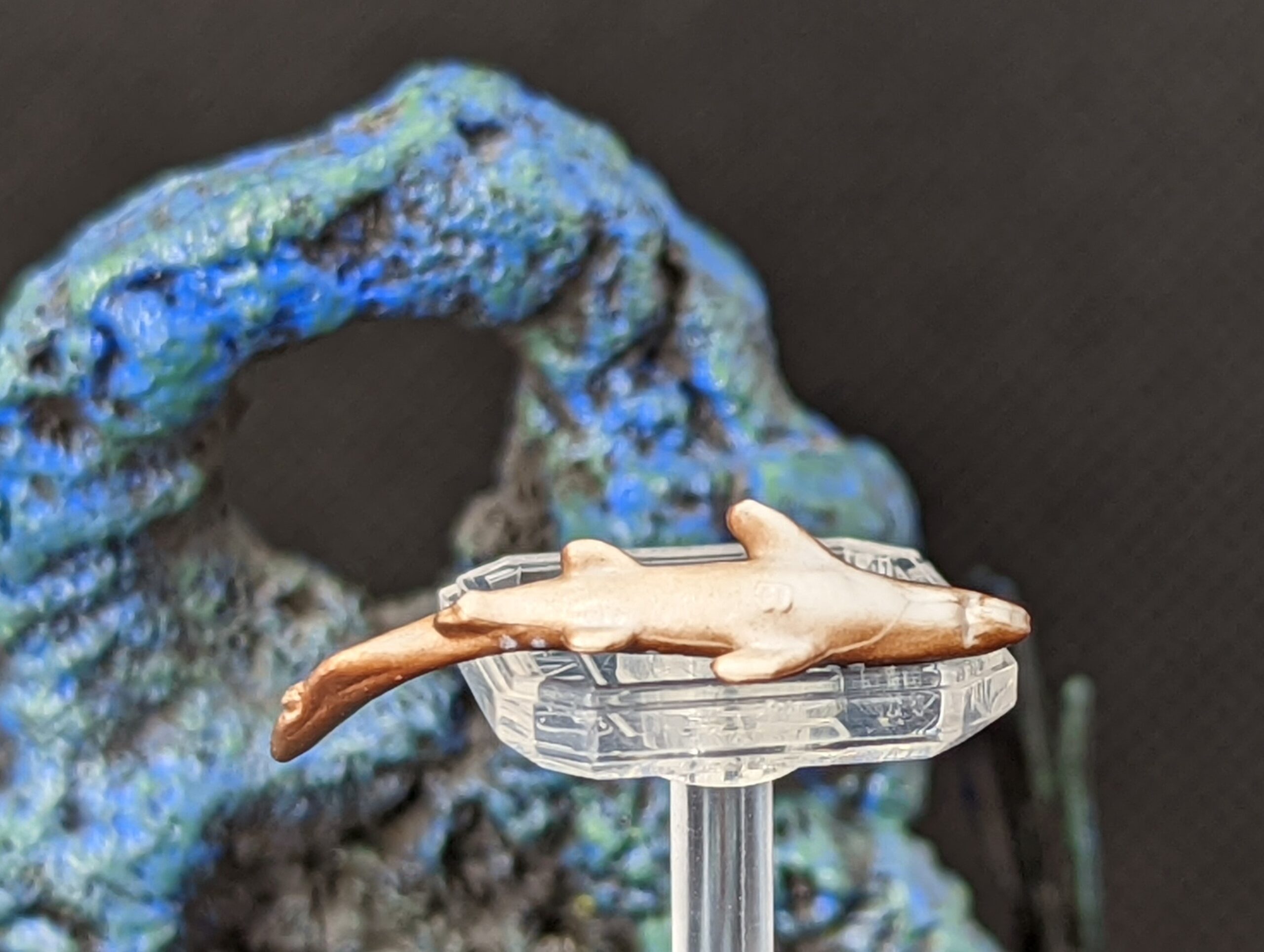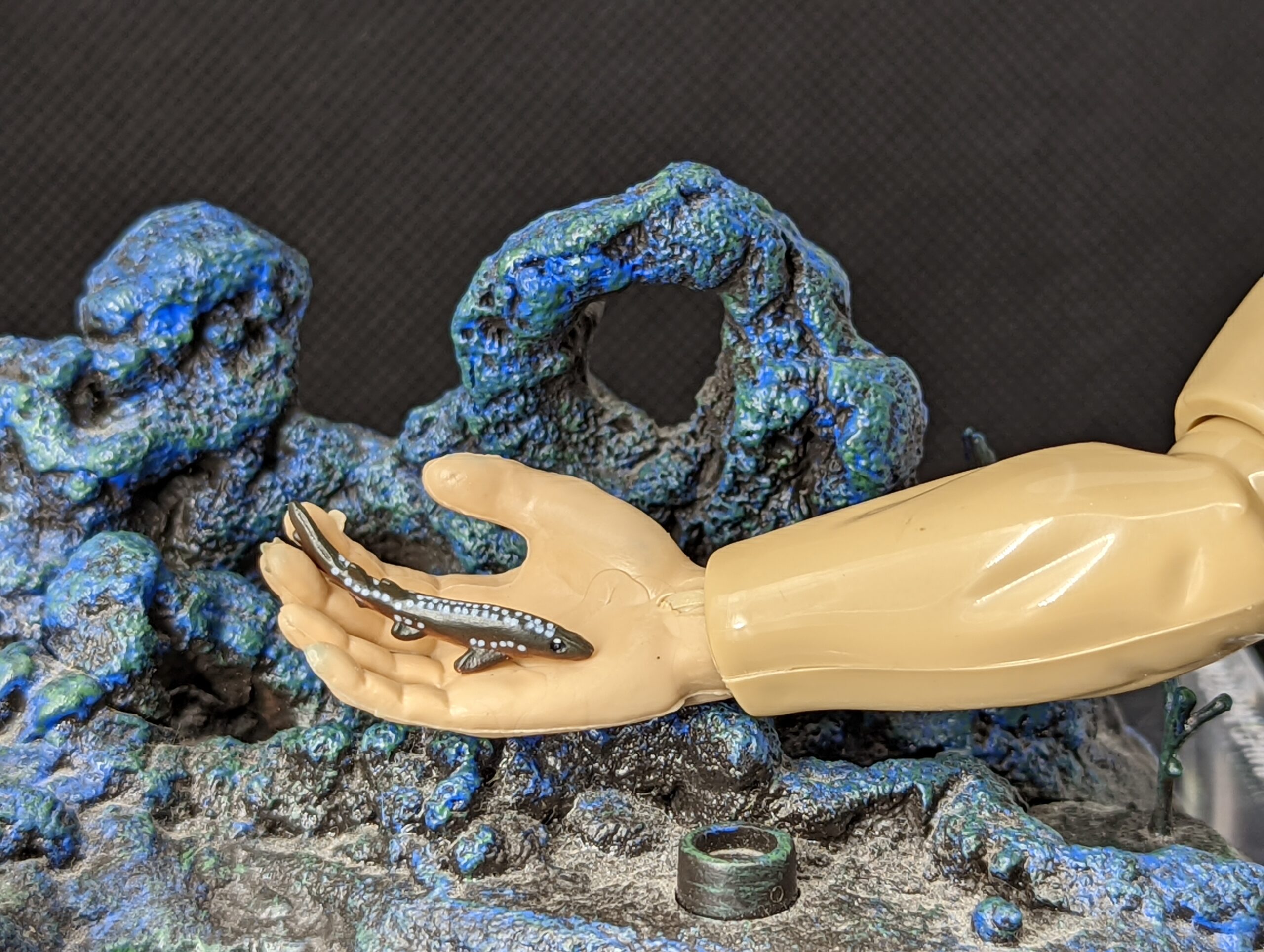So, it’s Shark Week again and once more I rise up from my own thing to bring in a couple of unusual shark models. Because I can never just bring up a more familiar figure because that’s too easy! So I’m going to look at a tiny little figure that just happens to represent a pretty tiny shark! Specifically, a very small figure of a probable Etmopterus spp (or at least a member of Etmopteridae), the Lantern Sharks.

Lantern sharks are a family of very unique sharks within the Squaliformes, popularly thought of as the dogfish sharks. Lantern sharks (Etmopteridae) contains about 45-50 species (depending on source…deepwater species tend to see frequent novel species identifications and updates). There are four extant genera of lantern sharks, but most are in the genus Etmopterus. As a group they tend to be more deepwater species, often along continental slopes but sometimes pelagic, distributed variously in waters worldwide in the Pacific, Indian, and Atlantic oceans. Most appear to be in Temperate or Tropical latitudes, although a few extend north of the Arctic Circle (again, in deep waters). Where it has been assessed, their population status are generally listed as Least Concern or Data Deficient…but being oceanic, sharks, and deepwater, we probably shouldn’t take anything for granted.

One of the most distinctive features of etmopterids is that most have some kind of light-producing photophores on their bodies. This is not limited to only this family of dogfish, or even just to squaliformes, but it is a common characteristic of the members of Etmopteridae. Other physical traits that unify them include their roughly equal-in-size pair of low and broad dorsal fins, with venomous spines on the leading margin of both. The tails are very asymmetrical, with a very short lower lobe and a long, broader upper lobe; a typical feature of this lobe is a notch near the bottom of the tip. The bodies themselves tend to be more or less cylindrical, with longer snouts. Notable for this figure we’re looking at, lantern sharks do not have anal fins.

In terms of habits and behaviours, lantern sharks are of course predatory animals, feeding on fish and sharks, molluscs, eggs, and other invertebrates. In other words–they’ll eat what they can find! Of course, given their small sizes, lantern sharks are also preyed upon by larger predators–including other lantern sharks! The species are most likely relatively solitary except during mating. For at least some species their vertical distribution appears to be stratified by age, with juveniles found in more shallow waters than the adults (maybe driven by that aforementioned predation on other lantern sharks).

That’s a whole lot of preamble to generalize a whole family of sharks…all to introduce a very tiny little shark figure that’s kind of hard to provide detail on. But it’s kind of a strange one, which makes it kind of fun to discuss! And it’s part of this shark family that doesn’t see a lot of attention as a toy/figure. This figure is from a set of very tiny shark figures produced by Wild Republic (possibly even under the predecessor brand K&M International). Except these figures were embedded inside of rubber bouncy balls! This figure is one of 12 in total (of varying identifiability). They were available in the mid-late 2000s, but it’s possible that it is from earlier. Wild Republic can be kind of inscrutable online, but I don’t think the ball sets are currently available. Obviously, my figure is not in the ball anymore–a simple (careful) cut with a scalpel and the ball split in two, freeing the tiny figure from within. No branding markings are present except for a large 8 (maybe a B?) but this is the same on all figures.

So the figure itself–it’s clearly very stylized, given the very small size of it. The overall body has the more or less correct cylindrical, cigar-shaped body with a rounded snout and ending in the proper caudal fin, with large upper lobe and very small lower lobe. The terminal notch is well-defined on the upper lobe, which is an important touch. The dorsal fins are appropriately small and similar in size, placed far relative to the pelvic fins (although the first dorsal fin should be between the pectoral and pelvic fins. The spines are not present. For the ventral fins, the pectoral and pelvic fins are small and rounded, if a little large. One glaring point is that from side there appears to be an anal fin present which is very not correct. That said, when looked at from below (see image above) there appears to be a ridge leading from the pelvic fins to what appears to be a pair of anal fins…perhaps this is actually a poorly rendered pair of claspers, indicating a male? I can’t find anything specific on what etmopterid claspers look like.

Other characteristic details are clearly present and surprisingly accurate (for what it is) while other elements are…less so. Gills are not sculpted at all (not surprised) but the typical subterminal mouth is clearly visible in an open position. It’s difficult to tell but it almost looks like the nostril slits are also present. The overall colour is a deep brown, fading to lighter brown at the ventral margin, with a mostly whitish underside. White dots, ostensibly representing photophores, are sloppily painted in two roughly parallel lines across the dorsal surface from behind the eyes to the base of the tail. There is also a longitudinal row along each side starting behind each pectoral fin–the dots do not match both sides (again, a little sloppy). The eyes are appropriately large, black with white spots; the right is mostly black with some small white splotches while the left is mainly white with an anterior black marking. The colours and proportions do not allow much for specific identification, so the figure stands best as a generic Etmopterus figure.

The size of the figure is really small–it is 2.3 centimetres long–so as far as similar sized models, you’d be looking at things like Schleich minis and Safari Good Luck minis. For scale, it depends on the species you’d determine (or need) this figure to be–for the largest species like the Blurred Lantern shark Etmopterus bigelowi at around 67cm, the figure would be around 1:30 scale, which would fit well with many other marine animal figures. At the smallest end, with a species like the Dwarf Lantern shark Etmopterus perryi (possibly the smallest known shark at maximum 20cm) the scale would be more along the line of 1:8 to 1:9 which might be a little trickier (I’ve included two different photos to represent potential scale representation with human counterparts). But with a tiny little figure like this, it would certainly suit many dioramas and scene works. Probably not great on a shelf display though, and would definitely be lost as a toy! Either way, as lantern sharks are not exactly readily available (the only other I know is a 3d printed Ninja lantern shark) it would be a unique addition to a collection, if you can find it. But let’s hope we see more deep sea and unusual shark figures made by our more familiar companies!
Disclaimer: links to Ebay and Amazon on the AnimalToyBlog are affiliate links, so we make a small commission if you use them. Thanks for supporting us!



